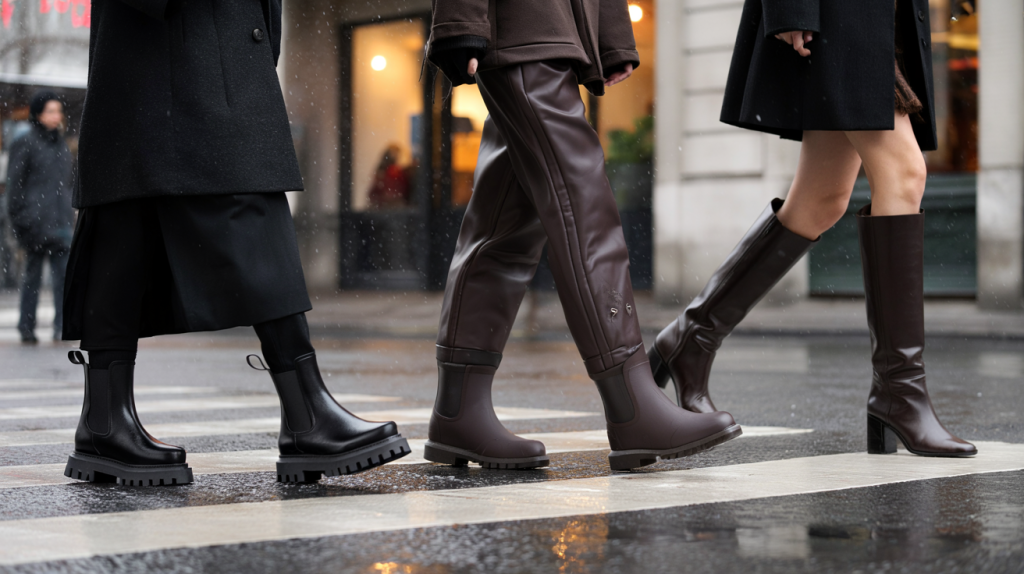Cold mornings, wet pavements, surprise slush. This season asks for women’s winter shoes that look sharp and handle real weather, not just the walk from taxi to door. The short list is clear: chunky Chelsea boots with lug soles, insulated waterproof lace-up boots for messy days, shearling-lined clogs for off-duty, and sleek knee-highs that still grip.
The point is practical style. Think traction that bites on slick tiles, liners that trap heat without a sauna effect, and leathers or textiles that shrug off rain. A good pair lasts, feels light, and pairs with denim, tailoring or a knit dress. That is the promise, now let’s make it happen.
Winter shoe trends for women: wearable, weather-smart, city to week-end
Designers kept the silhouette grounded this winter. Lug-sole Chelsea boots streamline outfits and add height without a wobbly heel. The shape stays neat around the ankle, so proportions work with wide-leg trousers and mid-length coats.
On truly wet days, insulated waterproof boots carry the outfit. Matte finishes and slimmer toeboxes mean no more moon-boot vibe. A simple black or chocolate upper reads dressy enough for office corridors, then takes on puddles at 6 p.m.
There is also the cozy lane. Shearling-lined clogs and low mules offer instant warmth for errands or a quick commute, then swap for loafers at the desk. Knee-high leather boots return with sensible block heels and hidden rubber outsoles, so grip improves while the line stays elegant.
Waterproof, insulation, grip: the tech that actually matters
Waterproof membranes do the heavy lifting. GORE-TEX cites roughly 9 billion microscopic pores per square inch in its membrane, each small enough to block liquid water yet large enough to let vapor escape. Source: W. L. Gore and Associates.
Insulation needs matching to the day. 3M indicates 200 g Thinsulate suits city cold, while 400 g targets deeper chills or slower activity. Above that, you enter long-outdoor-stay territory. Source: 3M Thinsulate technical guidance.
Some brands use PrimaLoft, a synthetic fill created in 1983 for the U.S. Army. It stays warm when damp and compresses easily, helpful in slim boots where space is tight. Source: PrimaLoft.
Underfoot, rubber compounds and lug patterns make the difference. Look for defined edges and siping, the thin cuts that improve wet traction. A heel brake helps on stairs and steep sidewalks. Traction weighs less than people think, but it changes how every step feels.
Common mistakes with winter shoes, and smart ways to fix them
Buying for the coldest day, then overheating all winter, happens a lot. Match insulation to routine. Active commutes need less fill than standing at a bus stop.
Waterproof is not breathable by default. Membranes breathe, but only if the lining wicks and the sock helps move moisture. That is the usual bottleneck.
Grip gets ignored until the first slip. A quick outsole check, in-store or online close-up, avoids that surprise. Flexible forefoot, visible lugs, and a rubber note in the materials list are simple tells.
Leather care often comes too late. A water-repellent spray on day one and after each clean keeps salt marks from setting into the grain.
Fit shifts in winter. Socks add volume, feet swell on longer walks, and a stiff upper softens after a week. A thumb-width at the toe frees the forefoot, then a snug heel stops rub.
Here is a one-minute checklist that keeps shopping focused.
- Outsole: deep lugs, siping, real rubber for wet grip.
- Weatherproofing: sealed seams and a named membrane or treated leather.
- Insulation: 200 g for city cold, 400 g for colder commutes, lined but uninsulated for mild days.
- Lining and socks: wool blend or wicking synthetics, not cotton.
- Fit test: winter socks on, walk a minute, check heel lock and toe room.
Smart shopping: materials, labels and care that extend boot life
Materials come with standards. In the European Union, chromium VI in leather has been restricted to 3 mg/kg since 2015 under REACH Regulation No 1907/2006. That reduces allergy risk without changing the look or feel. Source: European Commission, Annex XVII.
Look at construction. Cemented soles run lighter and cost less, while stitchdown or Blake/Rapid builds can be resoled and last longer. A gusseted tongue keeps water from sneaking through the laces, useful on slushy mornings.
Care adds months. Wipe salt rings with a damp cloth, then dry away from direct heat. Restore oils in leather with a balm, rotate pairs to let liners air out, and add a fresh coat of repellent after cleaning. Small steps, big payoff.
Color also plays a role. Dark neutrals hide winter marks and stretch wardrobes, while a sand or cream suede brightens heavy coats if treated early. One practical tip still stands: grip first, then silhouette. The right outsole makes a sleek boot definitly more wearable.
If the goal is less fuss and warmer feet, combine three elements in every pick. Real traction underfoot, weather protection that breathes, and insulation calibrated to the day. Get those right, trends fall into place without trying.
